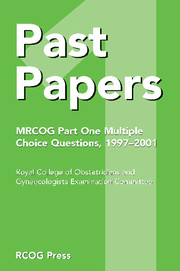Book contents
- Frontmatter
- Contents
- Introduction
- March 1997 – Paper 1
- March 1997 – Paper 2
- September 1997 – Paper 1
- September 1997 – Paper 2
- March 1998 – Paper 1
- March 1998 – Paper 2
- September 1998 – Paper 1
- September 1998 – Paper 2
- March 1999 – Paper 1
- March 1999 – Paper 2
- September 1999 – Paper 1
- September 1999 – Paper 2
- March 2000 – Paper 1
- March 2000 – Paper 2
- September 2000 – Paper 1
- September 2000 – Paper 2
- March 2001 – Paper 1
- March 2001 – Paper 2
- September 2001 – Paper 1
- September 2001 – Paper 2
- Index
September 1999 – Paper 2
Published online by Cambridge University Press: 05 July 2014
- Frontmatter
- Contents
- Introduction
- March 1997 – Paper 1
- March 1997 – Paper 2
- September 1997 – Paper 1
- September 1997 – Paper 2
- March 1998 – Paper 1
- March 1998 – Paper 2
- September 1998 – Paper 1
- September 1998 – Paper 2
- March 1999 – Paper 1
- March 1999 – Paper 2
- September 1999 – Paper 1
- September 1999 – Paper 2
- March 2000 – Paper 1
- March 2000 – Paper 2
- September 2000 – Paper 1
- September 2000 – Paper 2
- March 2001 – Paper 1
- March 2001 – Paper 2
- September 2001 – Paper 1
- September 2001 – Paper 2
- Index
Summary
1. Epidermal growth factor
A. is mitogenic.
B. synthesis is stimulated by oestradiol.
C. is a steroid molecule.
D. is found in endometrium.
E. binds to a receptor on the nuclear membrane.
2. Intracellular fluid differs from extracellular fluid in that
A. it forms the larger proportion of total body water.
B. its volume can be more readily measured.
C. it has a higher concentration of potassium.
D. its volume is more directly regulated by the kidneys.
E. it has a lower concentration of sodium.
3. Injected histamine produces
A. a fall in blood pressure.
B. decreased gastric secretion of hydrochloric acid.
C. bronchodilation.
D. bradycardia.
E. peripheral vasoconstriction.
4. The following are disaccharides:
A. glucose.
B. maltose.
C. sucrose.
D. fructose.
E. lactose.
5. The following are actively transported across the placenta from the maternal to the fetal circulation:
A. histidine.
B. alcohol.
C. ascorbic acid.
D. iron.
E. intrinsic factor.
6. Urea
A. is formed mainly in the kidney.
B. contains two amine (NH2) groups.
C. is formed by transamination from ketoglutarate.
D. is an end product of nitrogen metabolism in the fetus.
E. excretion is unrelated to protein intake.
7. Concerning amniotic fluid:
A. It has a protein concentration similar to that of maternal plasma.
B. It is mainly a filtrate of maternal plasma during the second half of pregnancy.
C. The highest bilirubin concentrations occur during the last trimester.
D. There is an increase in the α-fetoprotein concentration throughout pregnancy.
E. It contains cells of maternal origin.
- Type
- Chapter
- Information
- Past Papers MRCOG Part One Multiple Choice Questions1997–2001, pp. 111 - 120Publisher: Cambridge University PressPrint publication year: 2004



